Living on Mars
Going to Mars seems within reach and the question is not when, but how – how do you live on Mars?

“Touchdown confirmed. We are safe on Mars.”
It has been nearly nine months now that the Curiosity Rover touched down on Mars. Do not be fooled by its cockamamie drawing penchant: the Rover has identified traces of calcium (often associated with water), and a stream bed. Around Christmas 2012, the NASA team winnowed down rich in clay mudstone containing small amounts of carbon, oxygen, hydrogen, nitrogen, sulphur and phosphorus – the building blocks of life. The dizzying amount of data Curiosity has been sending is by all accounts changing our perceptions and the possibilities we envision.
The Curiosity Rover’s startling wander on Mars has energised burgeoning – and often private – space tourism endeavours. US millionaire Dennis Tito for instance thinks going to Mars is so simple that it just might work. His Inspiration Mars programme launched back in February 2013 aims at sending a couple of humans on a journey on January 5, 2018, as Mars and the Earth would align on this day which enables a no-fuss trajectory. They will return 501 days later having flown by, but not landed on, Mars. Albeit still scant details about the five-year development plan, NASA hailed “the adventurous spirit of […] citizen explorers”.
Bold minds have come up with Mars One, a non-profit/for-profit hybrid plan to send people settle a colony on Mars. Living on Mars thus does not seem to be a nut job any more. Mars Onewill train people – no specific skills required – for eight years prior to sending them in such a mission. Going to Mars seems within reach, and we are planning to send people to live there. The question is thus not when but how: how do you live on Mars?
The NASA does many things well, and the reason why is because it buries every problem in experts. Recently, the NASA used a crowd-sourced approach to better prepare the Mars Exploration Program. The NASA Space Apps Challenges make no exception: during a two-day (April 20-21) event held simultaneously in multiple cities across the world, experts from all backgrounds gathered to address a total of 50 challenges. These ranged from software to hardware and visualisation challenges, including robotics and citizen science platforms. Paris – where I live – also participated, and I was invited to lead the “Citizen Science” section.
There were several intriguing challenges in the citizen science section: none of the people in my team found her/himself the flamboyance of an Armageddon hijacker nor were we daring enough to grow space veggies. The enticement provoked by the Off-the-Grid challengedid, however, resonate with us: how could we live in a “self-sufficient manner without reliance on any public utilities”? This is, in other words, imagining how life in an outpost would be in the very detail, as travelling the 155 million miles back to Earth each weekend to do the groceries is hardly an option. For a planet of superlatives, we chose a challenge of superlatives.
|
|
| Curiosity Rover shows Mars could have supported life |
Earthlings going self-sufficient
The “Paris Off-the-Grid” team was composed by a software developer, a mechanical engineer, a video maker, a lawyer, a PhD candidate in sociology and yours truly (a rakish geek with background in genetics, among others). I first approached the challenge of creating an application that constantly surveys and communicates resources and needs of an autonomous colony quite nonchalantly. But the more we were talking about the make-up of such an app, the more I was shifting from seeing the snapshots of the whole to wrestling with details.
You want to monitor resources and prevent critical situations where the community would suffer, for example, insufficient food supply, that is… wait… what is a critically low food level for a Mars colony? How would you react in case of fire when toxic smokes immediately endanger the frail balance of gazes in the artificial atmosphere created for the humans?
Such giddy moments are of rare satisfaction for people who fancy identifying elegant fixes to quirky concepts. We thus adopted a prickly two-step approach: we first bootstrapped our application by locating it on Earth, establishing initial equipment and how manageable they are in the long run. Then, in order to establish the outpost on Mars, we surveyed how much recyclable and reusable these would be on a planet where everything is a dead weight if you cannot reuse it. A confession: swapping a complex, precise and proven technology for a simple, sloppy and unproven one is one hell of a riddle.
To break down the difficulty and incredible complexity of the challenge, here is the general idea: for every one thing that could go wrong on Earth, the Martian extrapolation has a thousand. On Earth, we picked a nice sunny and slightly windy location in South France surrounded by mountains on one side and valleys on the other. Air, wood, stone, cultivable terrains, water and wild boars are abundant there (yes, the majority of the team likes roasted meat). These raw materials allow to satisfy the primary needs of a human being for some time. We imagined to arrive with really basic tools and a few computers that would be especially necessary in emergency and high-voltage health situations. Of course, all pioneers should demonstrate a set of specific skills enabling them to be proactive in these conditions and substitute what is generally provided by public services.
Here is where our collective toolmaker’s muscle-flexing begot a splendid solution: let us gamify the whole set of criteria! We decided to create a simulation within which we have equipment, people and resources; the interactions and interdependency of these naturally affect minimal life conditions such as eating, drinking, sanitation, etc. In this case, we could set up a colony where people have distinct yet partly overlapping skills, and see how the community evolves over time while having to care for always enough and good-quality water, cereals, meat, proper shelter, etc. People’s capabilities of doing precise things are also a part of the simulation: is it better to have a majority of agriculture gurus and very few mechanical engineers, or vice-versa? Last but not least: is it easier to bootstrap a civilisation with 10 or with 50 people?
Bootstrapping the Martian Chronicles 2.0
Our simulation thus aimed at enabling a smoother transition from a self-sufficient and self-sustaining community on Earth to an outpost on Mars. We brashly picked the place: somewhere on the bottom of Mars’ “Grand Canyon”, Valles Marineris. We decided it would be fun to build a dome partly supported by the valley’s walls, under which we could create a human-friendly atmosphere which would help propel a convenient pressure where water would be liquid.
 |
| 3D-printed Martian dome habitat: Printing material is composed by 80 percent potato amidon [Rayna Stamboliyska/Al Jazeera] |
A yet-to-be-resolved question is whether installing wind turbines all around our dome is useful: with wind speeds equivalent to Earth’s hurricane, wind power seemed a good option. This speed might, however, be negligible as Mars atmosphere is around hundred times less dense than Earth’s, which naturally reduces wind speed. If wind power happened to be a poor option, we are still to find a solution for energy generation.
This bohemian splendour at the rim of a Martian jagged crease did not prevent us from lamenting the gaps in food supply. It is actually more than food when you think of the crucial role of… potatoes. No, I am not talking about vodka production here: potatoes provide substantial amount of sugar to the human organism, but this same sugar is a perfect raw material for 3D printing. Another existential question was which animals we should opt for: a cow that produces a lot of meat, milk and often methane, but require a considerable amount of water, or hens that give low amounts of meat, compensated for by eggs, no methane and little requirements of water. This is an open question thus far… and no offence to vegans intended.
After having settled down this rockabilly ambiance, we thought about textiles. There is no reason to not be sleek-looking on Mars. But more importantly, some textiles can outperform others in a totally unexpected situation. We thus decided we would all dress in linen rather than cotton: linen not only requires less water to grow, and is faster, but is also an isolator. In other words, when we would be reusing copper from out-of-order computer mother boards to make wires from, we would cover these with linen to avoid being electrocuted.
Speaking of style, we acknowledged that although our requirements for exquisite fashion would be somewhat reviewed, undimmed romance would eventually occur swiftly. What else could happen to a bunch of rationally confident and emotionally terrified men and women? We had a lively discussion over this specific question: how would we handle population growth? Above mentioned US millionaire Dennis Tito asked for a married couple beyond “a certain age”, that is pensioners. But the Inspiration Mars mission does not aim to settle on the Red Planet.
And if it is true that nobody can hear you argue in space, how about procreating the first Martian human generation? We were suggested to fly only homosexuals to Mars to bootstrap the new civilisation without bothering about procreation, or even to apply hormonal control to heterosexuals so that they have lesser sexual needs, thus low probabilities to mate. Conceivably (no pun intended), none of this was an ethically acceptable option. Our next challenge will be to extend our so far simple simulation system to include population growth in it, and thus attempt to account for the colony’s dynamics.
While Curiosity trundles around on the Red Planet’s surface, we hurtle through our imagination and lack of fears on the frontiers of possibilities as the morning dawns bright. It is a fine Martian day.
Rayna Stamboliyska is a research fellow at the Centre for Interdisciplinary Research at Paris 5 Descartes University where she develops the synthetic biology part of the Citizen Cyberlab project and co-organises the “Nightscience” 2013 event. She is also a blogger at SciLogs.com’s Beyond the Lab, which looks at emerging ways of doing science, at FutureChallenges.org and Jadaliyya. Rayna is board member of the French chapter of the Open Knowledge Foundation developing citizen science in France.
Follow her on Twitter: @MaliciaRogue
